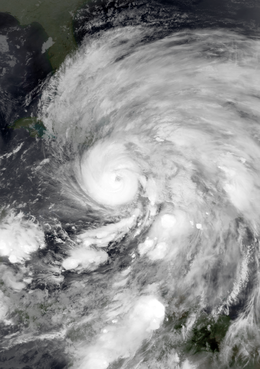Hurricane Matthew this month as well as Hurricane Sandy (2012), were abnormally destructive for North Atlantic Ocean tropical cyclones (which include typhoons and hurricanes).

(Boston Herald)
Tropical cyclones, typhoons and hurricanes
A tropical cyclone is a storm system characterized by a low-pressure centre surrounded by a spiral arrangement of thunderstorms that produce strong winds and heavy rain. Tropical cyclones strengthen when water evaporated from the ocean is released as the saturated air rises, resulting in condensation of water vapour contained in the moist air. The term "tropical" refers both to the geographical origin of these systems, which usually form in tropical regions of the globe, and to their formation in maritime tropical air masses. The term "cyclone" refers to such storms' cyclonic nature, with counter clockwise wind flow in the Northern Hemisphere and clockwise wind flow in the Southern Hemisphere. The opposite direction of the wind flow is a result of the Coriolis force.
The centre of these systems is characterised by extremely low atmospheric pressure (measured in hPa). The lower the atmospheric pressure in the centre, the greater the intensity of the storm. Depending on its location and strength, a tropical cyclone is referred to by names such as hurricane, typhoon, tropical storm, cyclonic storm, tropical depression, and simply cyclone.
The tropical cyclones in the northwest Pacific Ocean are the largest on earth on average, with North Atlantic tropical cyclones roughly half their size. What made Hurricane Sandy so destructive was the huge size rather than the intensity. It was only classified as a Category 1 Hurricane (104-133 km/h wind speed), whilst Hurricane Katrina which destroyed New Orleans was a Category 5 Hurricane (greater than 250 km/h wind speed). Hurricane Sandy was physically larger than the whole of South Africa when it was approaching New Jersey.

Hurricane Sandy as a Category 3 Major hurricane on October 25, 2012 (Wikipedia)
I had a look at the data available for tropical cyclones on Wikipedia.
They list the major tropical cyclone storm systems from the North Atlantic Ocean, Eastern Pacific Ocean, Western North Pacific Ocean, South-West Indian Ocean, Australian Region, South Pacific Ocean and South Atlantic Ocean with the year as well as the lowest pressure measured (intensity).
For each of the individual ocean basins, different threshold intensities are used by Wikipedia before they are added to the list.
This is because the storms in the various ocean basins tend to be very different in size with the most powerful being in the Western North Pacific, and only storms with an intensity of less than 900 hPa are listed. For the other ocean basins, 920 hPa is the threshold used except the South Atlantic Ocean where tropical cyclones are rare. Only 4 with an intensity of less than 1000 hPa are listed. The data for the North Indian Ocean is incomplete prior to 1990 and thus I excluded it from my analysis.
The following is observed:
- The number of large storms is increasing in all regions except the Western North Pacific Ocean. This region peaked in the 1960s-1980s.
- The intensity of the storms is increasing except in the Western North Pacific Ocean (staying constant or a very slight increase in intensity) and South-West Indian Ocean.
So it is thus concluded that the tropical cyclones are increasing in intensity as well as frequency in most regions of the world.
Hurricane Sandy was abnormally large for a North Atlantic Ocean tropical cyclone. The correlation with global warming and these trends would be expected and thus the world can expect more devastation as the temperatures rise, but the effects would be felt differently in different regions. The physical sizes of the storms would also appear to be increasing and thus they impact on larger regions.
Climate change is caused by factors that include oceanic processes (such as oceanic circulation), variations in solar radiation received by Earth, plate tectonics and volcanic eruptions, and human-induced alterations of the natural world (mainly by the increased emissions of greenhouse gasses like CO2). It’s this last cause about which all the debate and political squabbling is currently happening.
The industrialised nations like the USA would like to show that it’s not only the impact of their industries which have caused the global increases in temperatures and thus point to the other possible causes as well as historic variations in global temperatures. The emerging nations feel that the industrialised nations should be held liable for the current levels of CO2 and be allowed to develop to the same industrialised levels without any penalties.
And all the while the earth is crying out in agony as we continue to destroy our atmosphere.
http://en.wikipedia.org/wiki/Climate_change
http://en.wikipedia.org/wiki/List_of_most_intense_tropical_cyclones
http://en.wikipedia.org/wiki/Tropical_cyclone
In out pursuit of happynes, money and other things we mutilate this Earth.
I take this storms like antibodies in th bloodstream, because the come to protect the Earth.
Great article I really enjoyed it!Yep I agree @clint01!
Thanks
NOT CO2. wikipedia is lying to you.